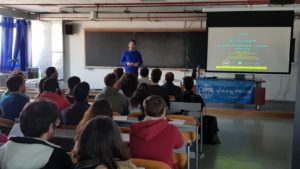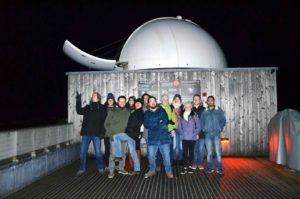[singlepic id=421 w= h= float=none]
Since ancient times, the study of the sky was not only of fundamental importance for life, but was always accompanied by a sense of fear and fascination linked to the magic of the cosmos. The scientific discoveries lead us to better knowledge of the universe and its boundaries.
In this frame, we organized a guided tour of the astronomical park “Gal Hassin” in Isnello, in the province of Palermo. It was a unique and formative experience for all the participants that had the possibility to visit and enjoy a park dedicated to the history of astronomy, as well as a spectacular planetarium, and of making night observation of the sky by means of professional telescopes.
After the bus trip from Messina to Isnello, the guided tour started visiting the outdoor astronomical laboratory, the “park of time and space”, with various types of solar clocks and other instruments such as the “Hipparchus Circle”.
Afterwards, we moved to the Planetarium. This fascinating educational machine for the reproduction of the celestial vault, with a dome of 10 m of diameter, is the first digital astronomical planetarium of Sicily; the entire dome is illuminated by 6 high resolution video projectors that make up the 360° image of the whole sky. Isnello’s Planetarium has been a powerful tool for the dissemination of astronomical concepts where the participants have been involved in a charming tour among the Moon, the Sun, the Milky Way galaxy with its constellations, Mars, Saturn, many other celestial bodies and curiosity about our universe.
Anyway, the most awaited moment was the night observation of the sky. So, in a terrace with 12 instruments for astronomical observations, after an initial introduction on several celestial bodies visible to the naked eye, the staff of the park guided us to the use of the different telescopes that allow the observation of planets and nebulae. In particular we could directly observe the Moon and Saturn.
Just after this, a “surprise” refreshment was offered to all the participants by the staff of the park.
The 54 participants were enthusiastic about this amazing experience and they appreciated the economic help received from EPS to pay part of the entrance ticket to the astronomical park.
[singlepic id=419 w= h= float=none]
[singlepic id=423 w= h= float=none]



![report_famelab_6[1]](http://www.epsyoungminds.org/wp-content/uploads/2018/04/report_famelab_61-300x200.jpg)
![report_famelab_5[1]](http://www.epsyoungminds.org/wp-content/uploads/2018/04/report_famelab_51-300x225.jpg)
![report_famelab_4[1]](http://www.epsyoungminds.org/wp-content/uploads/2018/04/report_famelab_41-225x300.jpg)
![report_famelab_3[1]](http://www.epsyoungminds.org/wp-content/uploads/2018/04/report_famelab_31-169x300.jpg)
![report_famelab_2[1]](http://www.epsyoungminds.org/wp-content/uploads/2018/04/report_famelab_21-225x300.jpg)



 Mghila Béni Mellal USMS section has set up several activities during the 2017. First, visits to schools in Beni Mellal region and the realization of solar tracer project.
Mghila Béni Mellal USMS section has set up several activities during the 2017. First, visits to schools in Beni Mellal region and the realization of solar tracer project. On November 28th 2017 in the evening, our student chapter DTU-Lys held a competition in the board game KHET, which is a complicated form of Chess, but with laser beams. Our student chapter owns 4 of these board games – a perfect number for hosting a competition with both group stages and knock-out rounds! The winner of the tournament was on beforehand promised a DTU-Lys t-shirt, which we had recently acquired a number of for outreach purposes. In total, this evening event numbered around 30 participants, with a good mix of Master students and PhD students.
On November 28th 2017 in the evening, our student chapter DTU-Lys held a competition in the board game KHET, which is a complicated form of Chess, but with laser beams. Our student chapter owns 4 of these board games – a perfect number for hosting a competition with both group stages and knock-out rounds! The winner of the tournament was on beforehand promised a DTU-Lys t-shirt, which we had recently acquired a number of for outreach purposes. In total, this evening event numbered around 30 participants, with a good mix of Master students and PhD students.
 On November 18th, SCOPE organised a night trip to the Scottish Dark Sky Observatory (SDSO) located in the edge of the Galloway Forest in Ayrshire.
On November 18th, SCOPE organised a night trip to the Scottish Dark Sky Observatory (SDSO) located in the edge of the Galloway Forest in Ayrshire.